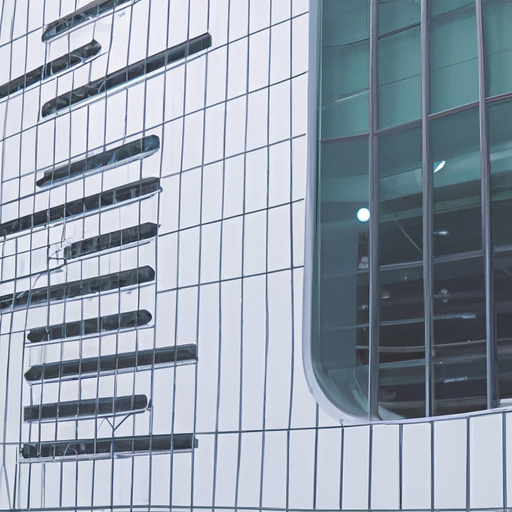Revolutionizing Architectural Design: AI’s Impact on Modern Complex Development
The role of artificial intelligence (AI) in various industries has been a topic of discussion for quite some time now. As technology continues to advance, AI has become an essential tool in many fields, including architecture and design. The development of modern complexes, which are large-scale, multi-purpose buildings that house various facilities such as offices, retail spaces, and residential units, has become increasingly complex. As a result, architects and designers are turning to AI to help them create innovative and efficient designs that cater to the needs of the people who will use these spaces.
One of the primary ways AI is revolutionizing architectural design is through the use of generative design. This process involves inputting specific design parameters, such as building size, location, and intended use, into an AI-powered software. The software then generates multiple design options that meet these criteria, allowing architects to explore various possibilities and choose the best one. This not only saves time and resources but also enables architects to create more innovative and efficient designs that may not have been possible using traditional methods.
Another significant impact of AI on modern complex development is its ability to analyze and process vast amounts of data. This is particularly useful when it comes to designing sustainable and energy-efficient buildings. AI can analyze data on factors such as local climate, sun exposure, and wind patterns to help architects make informed decisions about the placement of windows, the type of insulation to use, and the most efficient heating and cooling systems. This not only helps reduce the environmental impact of modern complexes but also results in long-term cost savings for building owners and occupants.
AI is also playing a crucial role in improving the construction process of modern complexes. By using AI-powered tools, architects and construction teams can identify potential issues and inefficiencies in the design and construction process before they become costly problems. For example, AI can be used to analyze building information modeling (BIM) data to detect clashes between different building systems, such as plumbing and electrical systems. This allows construction teams to address these issues before they become significant problems, saving time and money.
In addition to improving the design and construction process, AI is also being used to enhance the user experience within modern complexes. For example, AI-powered sensors can be used to monitor and analyze foot traffic patterns within a building, allowing architects and designers to optimize the layout of retail spaces, offices, and other facilities to improve the flow of people and enhance overall user experience. Furthermore, AI can be used to create personalized experiences for building occupants, such as adjusting lighting and temperature settings based on individual preferences.
Finally, AI is playing a significant role in the ongoing maintenance and management of modern complexes. By using AI-powered tools to monitor and analyze building systems, facility managers can identify potential issues before they become significant problems, allowing them to address these issues proactively and minimize downtime. This not only helps ensure the long-term success of modern complexes but also contributes to the overall satisfaction of building occupants.
In conclusion, the role of AI in designing modern complexes is multifaceted and far-reaching. From revolutionizing the architectural design process through generative design to improving the construction process, enhancing user experience, and ensuring the ongoing maintenance and management of these buildings, AI is having a significant impact on the development of modern complexes. As technology continues to advance, it is likely that AI will play an even more prominent role in shaping the future of architecture and design, leading to more innovative, efficient, and sustainable buildings that cater to the needs of their occupants.
AI-driven Innovations: Transforming the Landscape of Modern Complex Design

The role of artificial intelligence (AI) in various industries has been a topic of discussion for quite some time now. From healthcare to finance, AI has been making its presence felt by revolutionizing the way we approach problem-solving and decision-making. One such industry that has been significantly impacted by the advent of AI is the architectural and design sector. The integration of AI-driven innovations has transformed the landscape of modern complex design, making it more efficient, sustainable, and aesthetically appealing.
Traditionally, architectural design has been a labor-intensive process that requires a significant amount of time and effort from architects and designers. However, with the introduction of AI-driven tools and technologies, the design process has become more streamlined and efficient. AI algorithms can now analyze vast amounts of data and generate design options based on specific parameters, such as site constraints, building codes, and client preferences. This not only saves time but also allows architects to explore a wider range of design possibilities, ultimately leading to more innovative and functional complexes.
One of the most significant contributions of AI in modern complex design is the ability to optimize energy efficiency and sustainability. AI-driven software can analyze various factors, such as building orientation, materials, and insulation, to determine the most energy-efficient design. This not only helps in reducing the overall carbon footprint of the complex but also results in significant cost savings for the building owners and occupants. Moreover, AI can also be used to predict and monitor the performance of energy systems, such as solar panels and HVAC systems, ensuring optimal performance and reduced energy consumption.
Another area where AI has made a significant impact is in the realm of generative design. This approach involves using AI algorithms to generate multiple design options based on specific input parameters. The architect can then evaluate these options and select the most suitable one based on various factors, such as aesthetics, functionality, and cost. This not only allows for a more efficient design process but also enables architects to explore unconventional design solutions that may not have been considered otherwise. Furthermore, generative design can also be used to optimize the structural performance of a building, ensuring that it is both safe and efficient.
AI-driven innovations have also made it possible to create more accurate and detailed simulations of complex designs. These simulations can help architects and designers to better understand the impact of their design decisions on various aspects, such as pedestrian flow, thermal comfort, and acoustics. This, in turn, allows them to make more informed decisions and fine-tune their designs to achieve the desired outcomes. Additionally, AI can also be used to automate routine tasks, such as code compliance checks and material takeoffs, freeing up architects to focus on more creative aspects of the design process.
In conclusion, the integration of AI-driven innovations in the architectural and design industry has transformed the way modern complexes are designed. From optimizing energy efficiency and sustainability to enabling more innovative and functional designs, AI has proven to be a valuable tool in the hands of architects and designers. As AI technology continues to advance, it is expected that its role in the design of modern complexes will only grow, leading to even more efficient, sustainable, and aesthetically appealing buildings. The future of architectural design is undoubtedly intertwined with the advancements in artificial intelligence, and embracing this technology will be crucial for architects and designers to stay ahead in the ever-evolving world of design.
The Future of Urban Planning: How AI is Shaping the Design of Modern Complexes
The role of artificial intelligence (AI) in various industries has been a topic of discussion for quite some time now. From healthcare to finance, AI has been making its presence felt by revolutionizing the way we approach problem-solving and decision-making. One such industry that is witnessing a significant transformation due to the advent of AI is urban planning and design. The future of urban planning is being shaped by AI, as it plays a crucial role in designing modern complexes that cater to the ever-evolving needs of urban dwellers.
Urban planning is a complex process that involves the careful consideration of various factors such as land use, transportation, infrastructure, and environmental impact. Traditionally, urban planners have relied on their expertise and experience to make informed decisions about the design and development of urban spaces. However, with the rapid growth of urban populations and the increasing demand for sustainable and efficient living spaces, the need for innovative solutions has become more pressing than ever.
This is where AI comes into play. By leveraging the power of machine learning algorithms and advanced data analytics, AI can help urban planners make more informed decisions about the design and development of modern complexes. One of the primary ways AI is being utilized in urban planning is through the analysis of large datasets. Urban planners can now access vast amounts of data related to demographics, land use, transportation, and environmental factors, which can be used to identify patterns and trends that may not be immediately apparent to the human eye.
For instance, AI can help urban planners analyze the impact of different land use patterns on traffic congestion, air quality, and public health. By simulating various scenarios, AI can provide valuable insights into the potential consequences of different planning decisions, allowing planners to make more informed choices about the design of modern complexes. This can lead to the development of more sustainable and efficient urban spaces that cater to the needs of the growing urban population.
Another way AI is shaping the future of urban planning is through the use of generative design. Generative design is a process that involves the use of AI algorithms to generate multiple design options based on a set of predefined constraints and objectives. This approach allows urban planners to explore a wide range of design possibilities, enabling them to identify the most optimal solutions for a given context.
For example, generative design can be used to optimize the layout of a modern complex, taking into account factors such as building orientation, solar exposure, and wind patterns. By analyzing the performance of different design options, AI can help urban planners identify the most energy-efficient and sustainable solutions, ultimately leading to the creation of more environmentally friendly urban spaces.
Moreover, AI can also play a crucial role in enhancing the process of public engagement in urban planning. By using natural language processing and sentiment analysis, AI can help urban planners analyze the feedback and opinions of the public, allowing them to better understand the needs and preferences of the community. This can lead to the development of more inclusive and people-centric urban spaces that cater to the diverse needs of the urban population.
In conclusion, the future of urban planning is being significantly shaped by the integration of AI in the design and development of modern complexes. By leveraging the power of advanced data analytics, machine learning algorithms, and generative design, AI is enabling urban planners to make more informed decisions about the design of sustainable and efficient urban spaces. As urban populations continue to grow and the demand for innovative solutions becomes more pressing, the role of AI in urban planning is set to become increasingly important in the years to come.
Q&A
Question 1: How does AI contribute to the design of modern complexes?
Answer: AI contributes to the design of modern complexes by streamlining the design process, optimizing space utilization, and enhancing sustainability. It uses algorithms and machine learning to analyze vast amounts of data, identify patterns, and generate efficient design solutions that meet the specific requirements of a project.
Question 2: What are some specific applications of AI in designing modern complexes?
Answer: Some specific applications of AI in designing modern complexes include generative design, building performance analysis, and construction planning. Generative design allows architects to explore multiple design options quickly, while building performance analysis helps in optimizing energy efficiency and occupant comfort. AI can also assist in construction planning by predicting potential issues and optimizing resource allocation.
Question 3: How does AI impact the role of architects and designers in creating modern complexes?
Answer: AI impacts the role of architects and designers by automating repetitive tasks, enabling them to focus on more creative aspects of design. It also provides them with valuable insights and data-driven solutions, which can lead to more innovative and efficient designs. However, it is essential for architects and designers to adapt to these new technologies and develop skills to effectively integrate AI into their design process.
Conclusion
In conclusion, the role of AI in designing modern complexes is significant and transformative. AI technologies have enhanced the design process by automating repetitive tasks, optimizing designs, improving collaboration, and enabling data-driven decision-making. As a result, architects and designers can create more efficient, sustainable, and innovative complexes that cater to the evolving needs of society.


